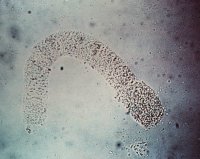
THE
SIGNIFICANCE OF CASTS IN URINE SAMPLES
First broadcast on www.provet.co.uk |
This information is provided by Provet for educational purposes only.
You should seek the advice of your veterinarian if your pet is ill as only he or she can correctly advise on the diagnosis and recommend the treatment that is most appropriate for your pet.
Casts are easily seen on microscopic examination of urine - but what are their significance ?
A "cast" is tubular shaped material seen on microscopic examination of a urine sample. They take their cylindrical shape from the shape of the lumen of the distal and collecting tubules of the kidney in which they form. Casts may have an homogeneous appearance or a granular appearance if other cells or materials become incorporated into them giving them.

A granular cast (unstained x560)
This picture is reproduced from the textbook "Diagnostic Cytology and Hematology of the Dog and Cat" by Cowell, Tyler and Meinkoth with the kind permission of Harcourt Publishers.
- Homogeneous casts
- Hyaline casts - Colorless, refractile, parallel edges, rounded ends. Small numbers (0 to 1 per high-powered field) may be seen in normal urine samples. Larger numbers are present in :
- Renal inflammation
- Fever
- Poor renal perfusion
- Pre-renal proteinuria
- Following strenuous exercise
- Following general anesthesia
- Waxy casts - Colorless, refractile, dull, opaque, waxy, parallel edges, flat ends, "fissures" on surface
- Granular-appearing casts
- Granular casts - One of the most common forms of cast. They contain remnants of tubular epithelial cells and white blood cells (see picture above). They are present in :
- Acute renal disease
- Tubular injury
- Cellular casts -Whole cells are present - ie epithelial cells, red blood cells, white blood cells
- White cells - seen in acute nephritis, toxicity with tubular degeneration.
- Leukocytes - pyelonephritis.
- Red cells - hemorrhage and inflammation
- Fatty casts - contain small fat droplets - round, refractile.
- Especially seen in cats
- Seen in dogs with diabetes mellitus
- Large numbers found in tubular degeneration
- Bilirubin-stained casts (yellow-orange)
- Hemoglobin or myoglobin-stained casts (red color)
- Haemoglobin - intravascular hemolysis
- Myoglobin - muscle damage
Last updated :January 2016
d>